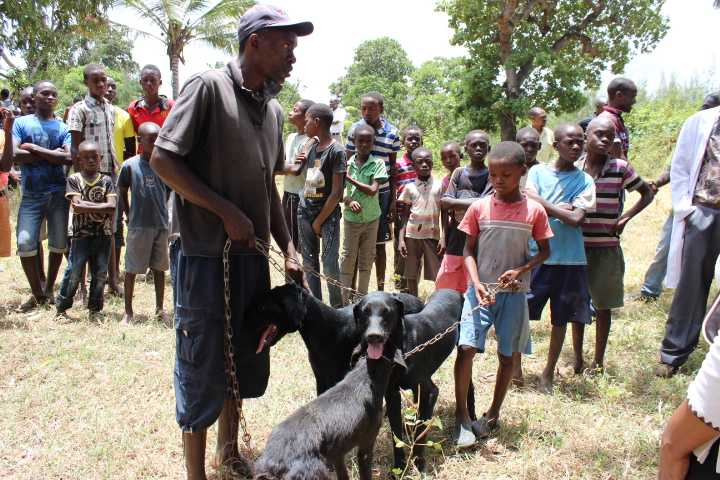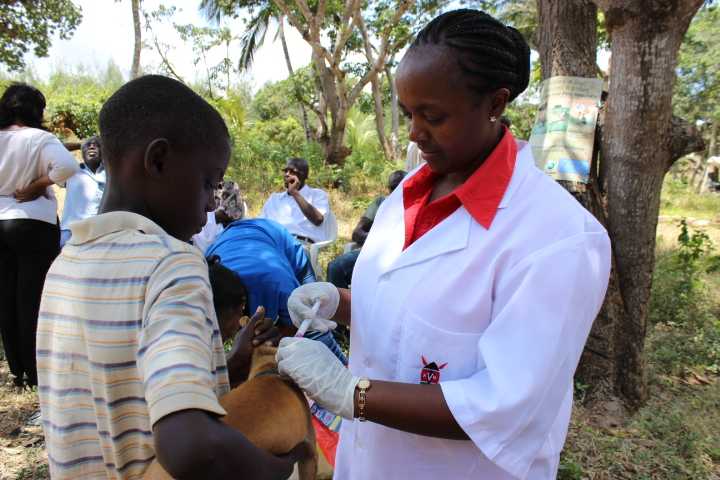Kenya makes great strides towards Rabies Elimination
Dogs enjoy a unique relationship with humans and share a special bond. But rabies can easily tear that bond to pieces. Rabies is a neglected zoonotic disease that is nearly always fatal in humans if appropriate preventive measures are not taken after exposure. Worldwide, it causes approximately 60,000 deaths annually mainly in developing countries with one person dying of rabies every 10 minutes. More than 95% of human deaths occur in Africa and Asia- and children below 15 years of age are at the greatest risk of rabies exposure.

Rabies has been endemic in Kenya since the first reported case in 1912. An estimated 2, 000 people die annually of rabies after being bitten by rabid dogs in the country. Despite this elevated mortality, current efforts to prevent the rabies infections has mostly been restricted to treating individuals after a dog bite and random dog vaccinations, with little investment in sustainable prevention and control plans. In 2012 the government of Kenya set up a Zoonotic Disease Unit (ZDU) to improve the surveillance, prevention and control of zoonotic diseases in the country. Rabies was identified as one of the highest priority diseases.

Last year in September 2014, Kenya became the first country in Africa to launch a national strategy for controlling and eliminating human rabies. The new plan was launched by Kenyan government principal secretaries, from the Ministry of Health and Ministry of Agriculture, Livestock and Fisheries. The objective of the strategy is to eliminate dog mediated human rabies by 2030. The strategy is simple: vaccinate at least 70% of the dog population each year – for at least three years – and the disease will be eliminated in dogs, humans and wildlife. More than 70% of dogs in Kenya are owned and are accessible for parenteral vaccination. Dog vaccination is a cost effective strategy, saves lives and results in decline in the use of costly post-exposure prophylaxis in humans.

CDC in Kenya has been pivotal in the development of the rabies elimination plan by providing funding and technical assistance in development of guidelines on surveillance, rabies prophylaxis and dog vaccination. Additionally CDC in the last few years has provided training in the use of a direct Rapid Immunohistochemical Test to multiple organizations including the Kenya Veterinary Association, Kenya Medical Research Institute, National Public Health Laboratory Services, and the Central Veterinary Laboratories. The rapid test for rabies diagnosis was developed in 2011 by CDC’s division of High-Consequence Pathogens and offers a rapid, specific, sensitive and cost-effective tool for diagnosing the disease. The test is ideal for use in the field as it can be performed on a bench top and requires no specialized equipment and provides diagnostic results in an hour.

This years’ World Rabies Day, Kenya celebrated the first anniversary of the launch of its strategy to eliminate rabies by 2030 where more than 1,000 dogs were vaccinated in Malindi County. During the event, the principal secretary for Livestock, Fred Segor, was hopeful that, “With the help of partners such as World Animal Protection and CDC, we hope that by the year 2030, we will have a rabies free nation.” The recent vaccinations and awareness programs are an excellent example of the One Health approach, in which a cross-cutting team from veterinary health, public health and wildlife health combined energies to have a unified defense against a health threat that can easily persist if there are gaps when all these sectors are not linked. Given the extent of collaboration and communication amongst the various sectors and disciplines within the animal and human health communities, well-coordinated campaigns have been a great success in regards to vaccination rates and rabies awareness programs that aim to prevent dog bites and rabies in humans, companion animals and livestock.
- Page last reviewed: November 3, 2015
- Page last updated: November 3, 2015
- Content source:
Global Health
Notice: Linking to a non-federal site does not constitute an endorsement by HHS, CDC or any of its employees of the sponsors or the information and products presented on the site.


 ShareCompartir
ShareCompartir